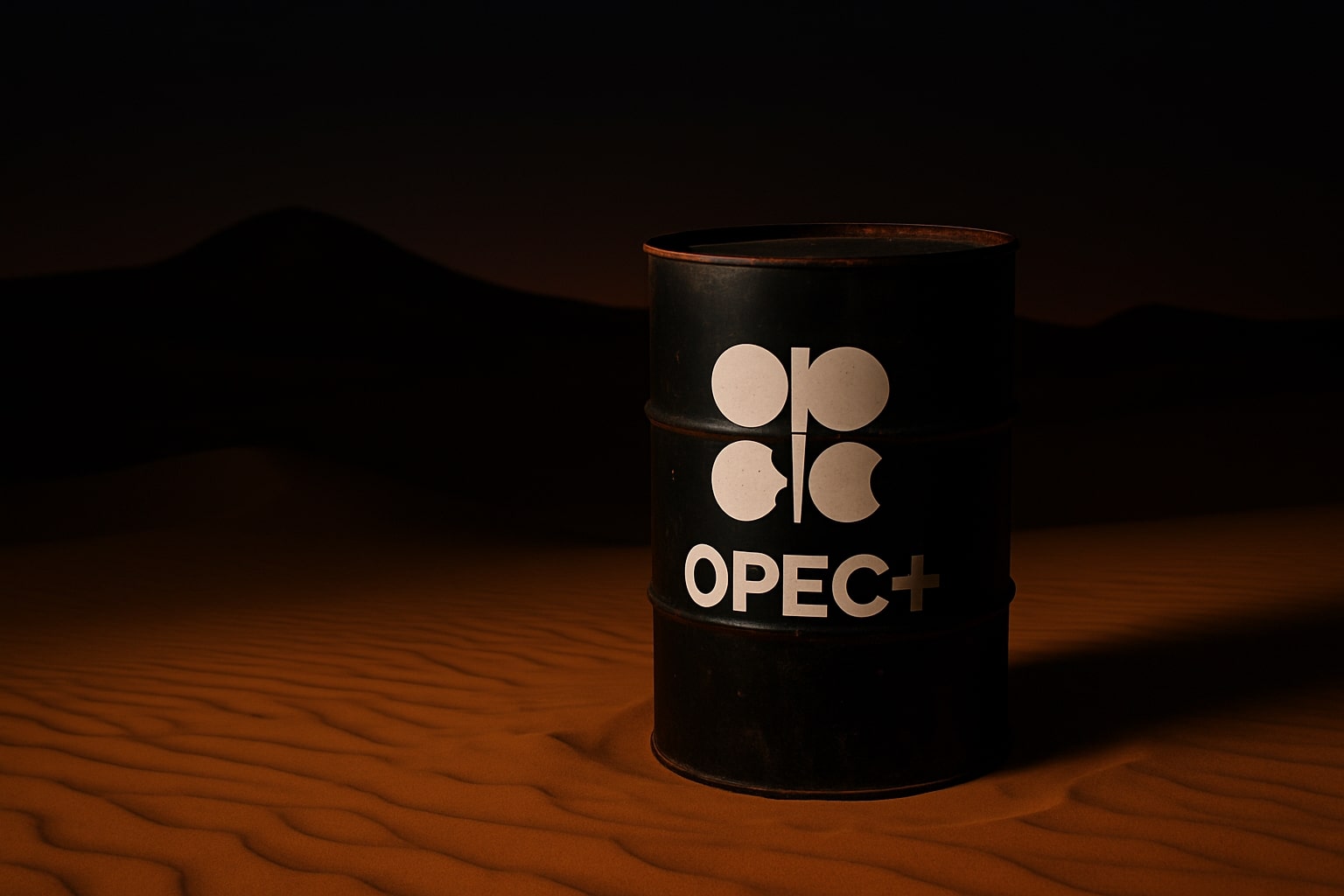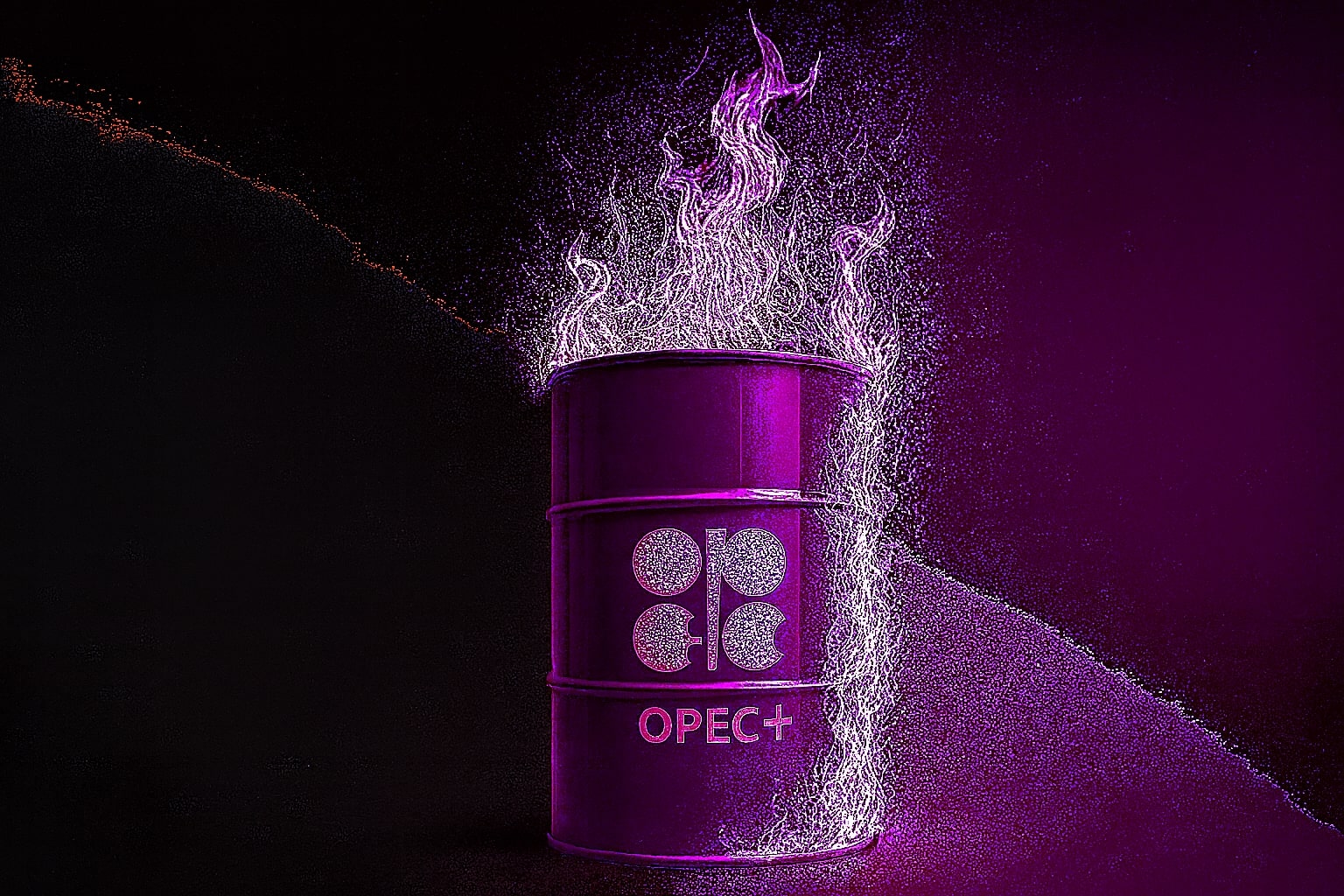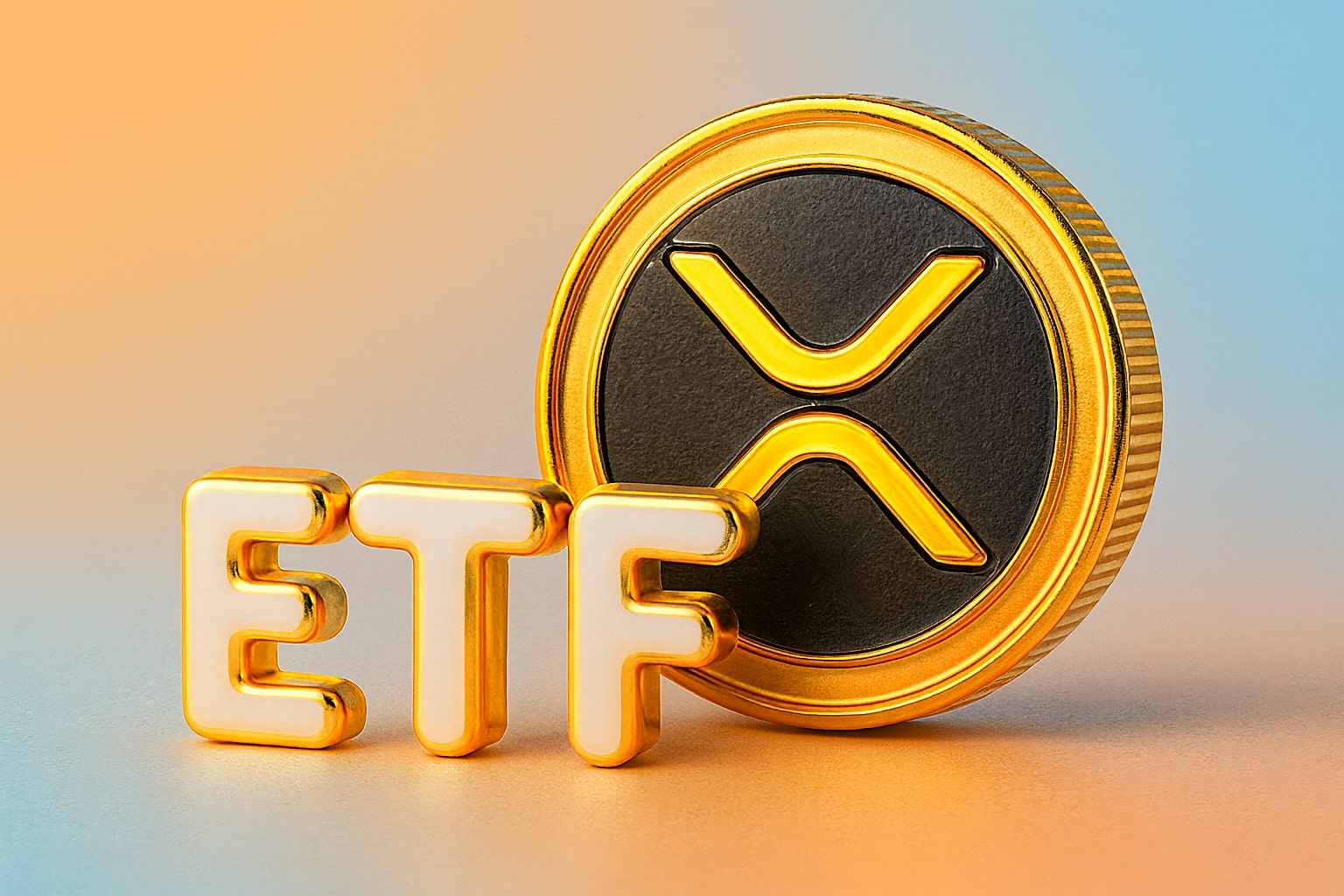Geopolitical Risk Premium Collapses as Brent and WTI Retreat Sharply
Oil markets unraveled in spectacular fashion this week as West Texas Intermediate (CL=F) crashed to $65.52 and Brent (BZ=F) closed at $67.77, both recording a brutal 12% weekly loss—their steepest drop since March 2023. The sharp reversal came after the Israel-Iran ceasefire erased risk premiums that had briefly pushed Brent to $81.40, following U.S. airstrikes on Iranian nuclear facilities. Traders had priced in a full-blown disruption scenario through the Strait of Hormuz, but the swift diplomatic de-escalation stripped away nearly $14 per barrel in under two weeks. Options markets now assign just a 4% probability to any supply blockage through Hormuz, signaling that markets are rapidly returning to fundamental drivers.
OPEC+ Triggers Midday Collapse with August Supply Surge
Crude’s intraday spiral deepened after four OPEC+ delegates confirmed plans to lift production by 411,000 barrels per day in August, continuing July’s increase. The midday shock sent oil plunging before short-covering helped recapture modest ground into the close. Despite Friday’s fractional rebound, sentiment remains fragile. Brent briefly dipped under the critical 200-day moving average at $65.15, a line that now acts as a technical pivot. A decisive close below could open the door to fresh declines toward $61, while upside targets remain at $67.44 and $71.20. The supply expansion suggests OPEC+ sees enough demand recovery to justify higher output, but it also challenges the market’s ability to absorb new barrels without reigniting a structural glut.
U.S. Rig Count Hits New Lows as Producers Hold Back
Domestic production signals remain weak. According to Baker Hughes, the U.S. oil rig count fell by six to 432, its lowest since October 2021. The drop marks the fourth straight monthly decline and a 47-rig YoY reduction, underlining ongoing caution among U.S. shale producers. Despite earlier Brent rallies, producers appear unwilling to chase growth amid macro uncertainty and policy risks. The persistent downtrend in rig activity suggests any production growth will increasingly rely on inventory drawdowns and efficiency gains, not fresh drilling.
Airline Fuel Economics Improve as Jet Prices Slide and Passenger Revenues Climb
Fuel-sensitive sectors like aviation are finally catching a break. IATA forecasts 2025 passenger revenue to reach $693 billion, a 1.6% gain YoY, while total industry revenue is expected at $979 billion. Jet fuel costs are forecasted to average $86 per barrel, down from $99 in 2024, lowering industry-wide fuel expenses from $261 billion to $236 billion. This tailwind is already unlocking capital returns: Delta Air Lines just raised its dividend 25% to $0.1875 per share, its second hike since the COVID pause. With lower oil prices directly improving airline margins, the demand side of the barrel is benefiting even as crude benchmarks suffer.
Tesla’s Megapack Bet in China Challenges Fossil Grid Reliance
Tesla’s pivot toward grid-scale storage is now gaining geopolitical weight. The firm signed a $556 million deal to deploy its Megapack batteries in China, which are capable of delivering 1 MW for four hours each. With over 100 Megapacks built in Q1 at its Shanghai factory, Tesla is expanding aggressively into a market dominated by CATL and BYD, who control over 40% of global battery supply. China's renewables footprint now exceeds 886.67 GW in solar and 520 GW in wind, having met its 2030 target six years early. Storage solutions like Tesla's will be critical to stabilize that intermittent capacity and displace fossil-fueled backup. This transition poses a longer-term risk to crude’s utility function in electricity generation, especially as battery exports from China begin to scale globally.
India Warns on Hidden Crude Risks Despite Falling Prices
India’s Ministry of Finance remains on alert despite a 6–7% post-ceasefire decline in oil prices. Officials highlighted hidden risks from insurance premiums and Strait of Hormuz exposure, which could raise landed costs regardless of nominal crude benchmarks. While the economy is showing resilience—projected to grow 6.5% in 2024–25, with strong e-way bills, PMI data, and improved rural demand—any further shock to supply chains could derail the fragile macro balance. The current environment, described as a “relative goldilocks,” hinges on stability in global energy trade, which remains vulnerable to new disruptions.
European Retail Prices Rise Again as Brent Volatility Filters Down
Ireland’s motorists are feeling the sting again. After a May reprieve, petrol rose to €1.77/L and diesel to €1.69/L, due to the delayed impact of June’s Brent price whiplash. The typical two-week lag between Brent purchases and pump pricing is ensuring that earlier crude spikes are still filtering through. Brent’s move from $75.47 (Apr 2) to $58.40 (Apr 9), back to $81.40 (June 23) and then $66.98 shows how volatile input costs have become. With over €1/litre going to taxes (excise, carbon, VAT), the debate in Ireland is shifting toward a possible overhaul in how heating and transport fuels are taxed.
Inventory Drawdowns Point to Underlying Demand Strength
Despite price softness, crude demand signals are firming. The EIA reported a 5.8 million barrel draw last week, with commercial stocks at 415.1 million barrels, the fifth straight weekly drop. API data showed a steeper-than-expected 4.27 million-barrel fall, while distillate stocks in Singapore and the ARA hub declined sharply. Rising refinery runs and net exports from Asia indicate the physical market isn’t as oversupplied as futures imply. Analysts noted that these inventory trends are starting to build a floor under crude, even as OPEC+ adds supply and traders unwind long positions.
China’s Record Iranian Crude Intake Exposes Market Resilience
Beijing is soaking up barrels even as prices sink. From June 1–20, China imported 1.8 million bpd of Iranian crude, the highest on record per Vortexa. These purchases ramped up ahead of the Israel-Iran war, demonstrating strategic foresight by Chinese refiners. As the world’s top crude importer, China’s behavior often sets the tone for marginal demand. Their ability to boost imports while maintaining refinery margins sends a clear message: demand remains sticky in Asia even as geopolitical events inject volatility elsewhere.
Speculative Risk Fades but Market Still Watches Hormuz
The rapid de-escalation between Israel and Iran restored calm, but the market’s risk memory remains short. The Strait of Hormuz, which moves one-quarter of global seaborne oil, saw no direct hits during the conflict, calming fears of a disruption. Goldman Sachs analysts put the chance of Hormuz closure at just 4%, yet note that if it were blocked, Brent would immediately surge to $90. Current volatility largely stems from sentiment swings and headline reactions, not structural shortages—though the fast liquidation of long positions reveals how thin conviction remains after geopolitical catalysts fade.
Final Rating on Oil (CL=F, BZ=F): Tactical Hold with Bearish Tilt
The brutal selloff in crude strips away any illusion of bullish momentum. Inventory trends are supportive, but not enough to offset the psychological weight of OPEC+ oversupply, macro risk unwinding, and Tesla-led substitution pressure. The technical floor at $65.15 held for now, but conviction is lacking. The risk of a grind lower toward $61 is real unless inventories tighten further or demand sharply accelerates.
Given the mix of weakening fundamentals and fading catalysts, WTI (CL=F) and Brent (BZ=F) are a Hold, with downside bias. Traders should watch $67.44 and $71.20 on the upside for any speculative relief rallies. Until then, market participants remain stuck in a volatile sideways churn, awaiting the next macro shock to dictate direction.




















